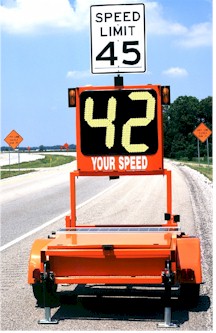 A member of Illinois law enforcement who specializes in traffic issues told me that Illinois uses speed display trailers for speed zoning studies.
A member of Illinois law enforcement who specializes in traffic issues told me that Illinois uses speed display trailers for speed zoning studies.
A little background: the commonly accepted way to set speed limits is to measure the speed of passenger vehicles in a way that is not apparent to motorists. From that speed survey a traffic engineer sets a limit that legalizes most drivers and criminalizes only the fastest, most dangerous drivers.
Speed trailers bias the speed of traffic so that it conforms to the currently posted limit. For example, you will probably slow down if the speed limit sign says 50 but “YOUR SPEED” says 58.
This practice reinforces the currently posted speed limit even where properly run speed zoning studies would have required a higher limit.
What does this mean for the everyday motorist? Ever lower speed limits, causing wider gaps between the fastest and slower drivers, more tickets, and more safety problems.
In a practical sense, the commonly accepted speed zoning practice is usually overridden by arbitrary laws or politics. On nearly every road in the U.S., speed limits are already set so low that nearly everyone is a lawbreaker. Short circuiting speed zoning so that it just reinforces the currently posted limit is a shameful, corrupt, revenue-enhancing practice.
Illinois drivers should be infuriated.
 I have been assigned an adviser in the Doctor of Engineering in Engineering Management program. He says that I am probably accepted into the program. It sounds like all that remains are procedural issues, mostly paperwork.
I have been assigned an adviser in the Doctor of Engineering in Engineering Management program. He says that I am probably accepted into the program. It sounds like all that remains are procedural issues, mostly paperwork.